Opening Times:
Monday to Thursday and Saturday
- 9.30 to 4.30pm
- 9.30 to 4.30pm
Friday and Sunday
- 9.30 to 4.00pm
- 9.30 to 4.00pm
Last entry
- 30 minutes before advertised closing time.
- 30 minutes before advertised closing time.
HISTORY OF DARTMOOR PRISON
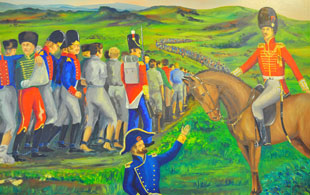
Prisoners of War
From 1803 to 1815 Britain was at war with Napoleonic France and many thousands of prisoners were taken. To help accommodate them redundant warships were commissioned as floating prisons known as ‘the hulks’. Several hulks were at anchor at Plymouth among other places and conditions were so bad with poor sanitary arrangements, little exercise, lack of fresh air and a poor diet, the death rate rose to an unacceptable level and a prison on land was decided upon. Princetown on Dartmoor was considered a suitable location and that is how Dartmoor Prison came to be built.
CONSTRUCTION
 Painting by artist Paul Deacon
Painting by artist Paul Deacon
Construction Begins
Sir Thomas Tyrwhitt, founder of Princetown and a close friend of the Prince of Wales (who owned the land) was instrumental in deciding where the prison should be built and he it was who laid the Foundation Stone on 20th March 1806 when building work began. The first prisons were constructed from stones obtained by breaking up the boulders lying around the site supplemented by dressed stone from nearby Herne Hole quarry (owned by Mr. Tyrwhitt). Construction planned for completion in just a year and a half took twice as long due to labour disputes and the notorious Dartmoor weather.
PRISONERS OF WAR

The First Prisoners
First prisoners arrived on 22nd May 1809 and the prison was full by the end of the year. It soon became overcrowded and remained so. In April 1813 American prisoners began arriving and the overcrowding became worse. Outbreaks of diseases – pneumonia, typhoid, smallpox, etc. killed more than 11,000 Frenchmen and 271 Americans. Their graveyards and memorials are at the rear of the prison. The wars finally ended and the prisoners were repatriated, the last of them leaving in early 1816. The prison then closed until opening again as a penal establishment for criminals in 1850.
CONVERSION TO A CONVICT JAIL 1850
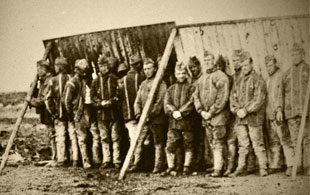
Victorian Convicts
The first convicts transferred mainly from the convict prison ships on the Thames and at Gosport. Most of them were invalids, imbeciles, one armed and one legged men, others with chest complaints who it was thought would benefit from the fresh Dartmoor air. Cast-iron cells arranged back to back were constructed by artisan convicts under the supervision of contractors. These were superseded by stone cells before finally the older prisons were demolished and replaced by the buildings you see today, also built by convicts under artisan warders supervision. They were occupied by the worst criminals in the land.
WORLD WAR ONE AND CONSCIENTIOUS OBJECTORS
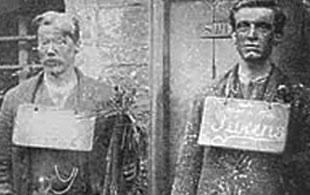
The ‘Conchies’
The Military Service Act of 1916 introduced compulsory Conscription. ‘Conscientious Objectors’ or ‘Conchies’ as they were called could apply before Tribunals for exemption on moral or religious grounds and either accepted non-combatant duties or agreed to serve at a Government Labour Camp. In 1917 Dartmoor prison was designated a Labour Camp and around a thousand such men replaced the convicts, occupied their cells and performed the same work as they had done. All locks were removed, they had freedom of movement locally and the Warders acted as supervisors only. They and their families were generally despised and suffered much hardship.
THE 1932 MUTINY
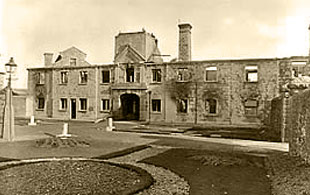
Mutiny!
On Sunday 24th January 1932 during morning exercise around fifty men broke ranks armed with home - made coshes and the riot began. They soon had control of the yards and associated buildings, attacking anyone in their way and outnumbered officers retreated to safety. The Administration block was set on fire and irreplaceable prison records lost. Police from Plymouth were rushed to Dartmoor supported by soldiers from Crownhill barracks. The trouble was quickly quelled and the ringleaders later tried and convicted. Ropes, grapnels etc. afterwards found confirmed suspicions the riot was a cover for an (unsuccessful) escape plan.
PRISON LIFE TODAY
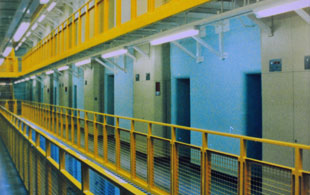
Dartmoor Today
The bad old days are gone – no more quarrying, digging the barren moorland by hand under armed guards, and brutal punishments have been abolished. We now hold low category prisoners who are encouraged to undertake training programmes to help them on their release. Skilled advisors hold discussion sessions to make them aware of how unacceptable their crimes are. Single cell accommodation still applies and they eat in their cells. Showers and telephone communication with their families are freely available. They are not here to be punished; their punishment is loss of liberty tempered by help towards reform and rehabilitation.
